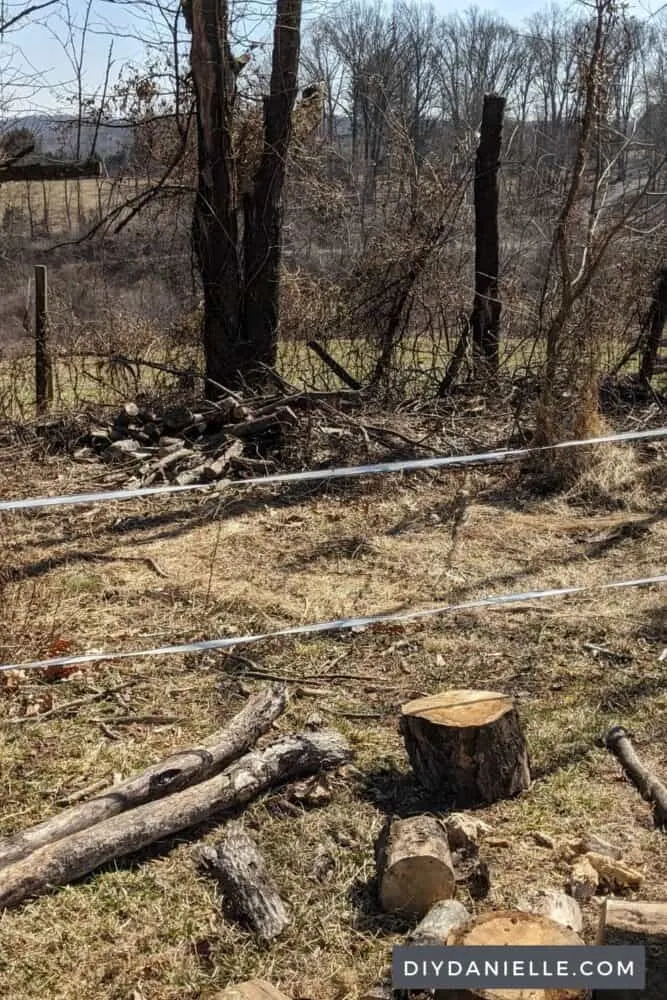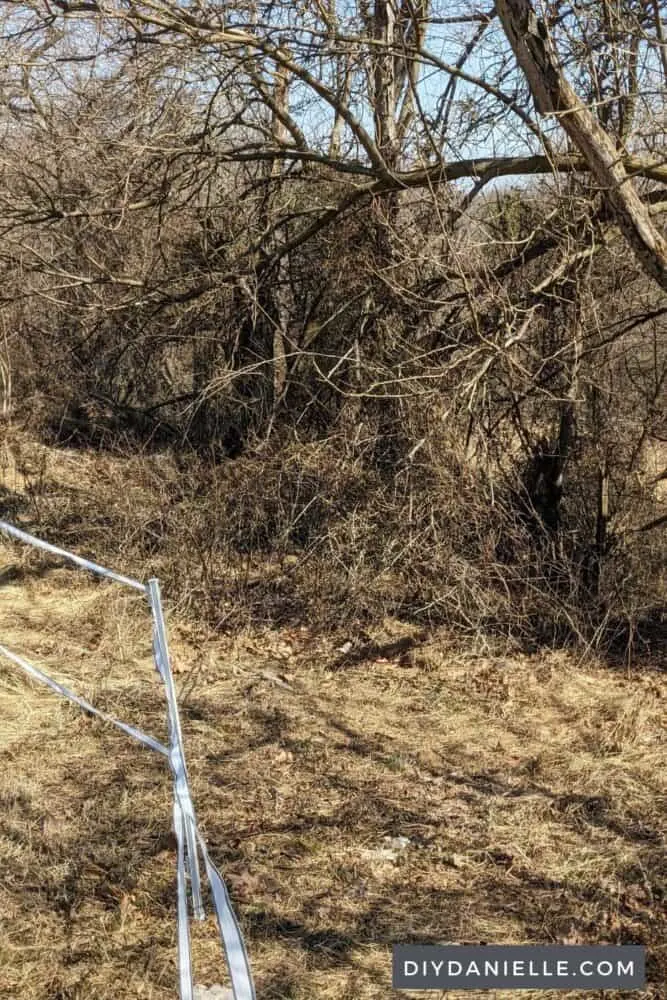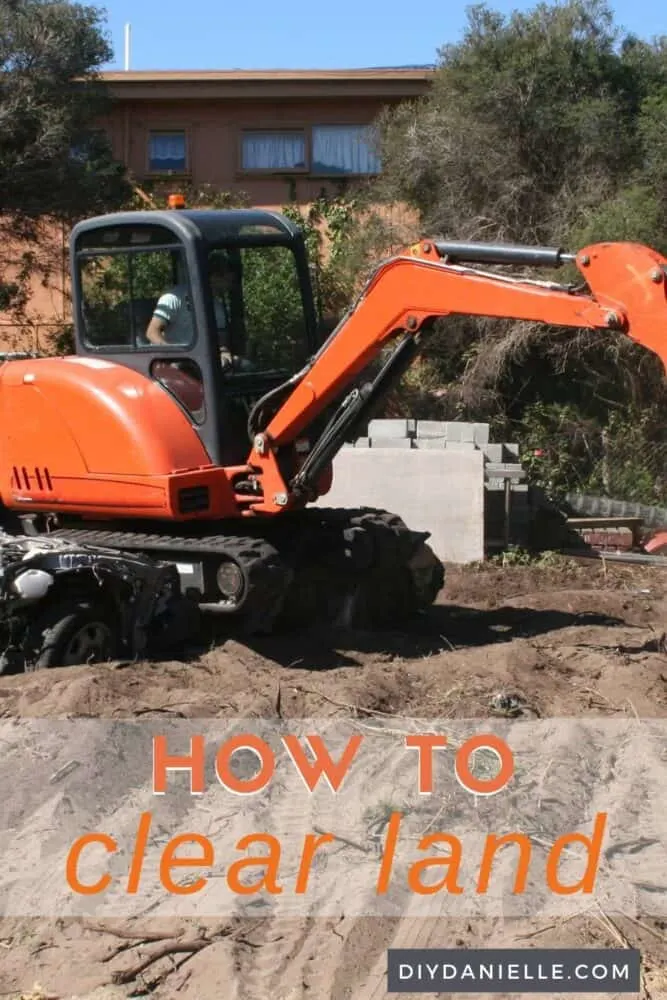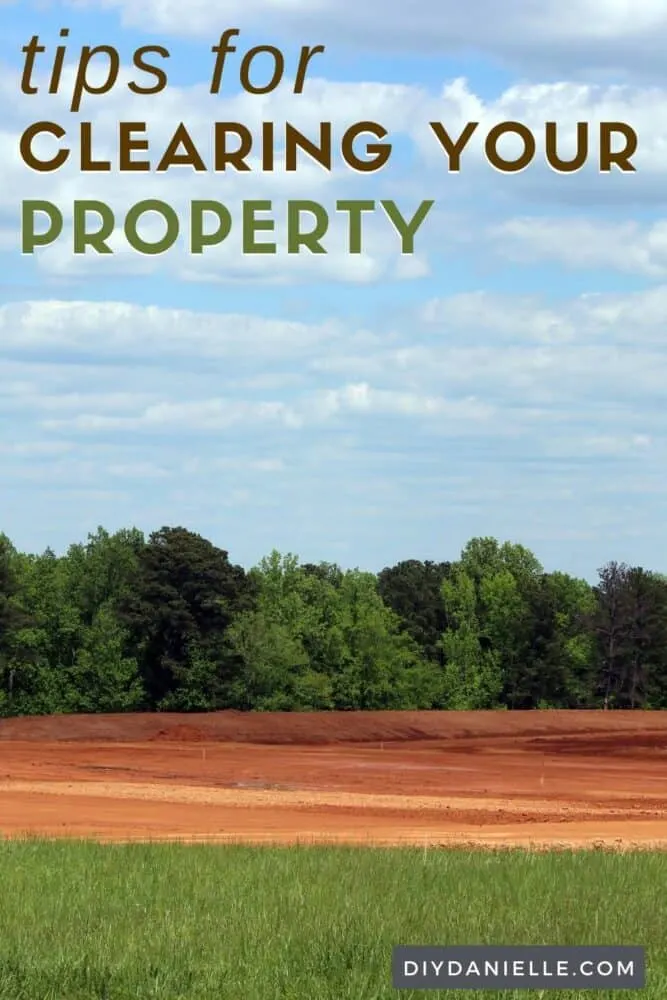
This comprehensive guide to land clearing for beginners outlines essential steps, equipment, and considerations to transform your property effectively. Whether preparing land for construction, farming, or landscaping, understanding the process is crucial for success.
Sometimes the perfect piece of land for a pasture, lawn, or house contains a large amount of overgrowth that needs to be cleared before you can make use of it. This can be a tough process, depending upon the condition of the property. The methods, amount of labor, and cost involved in clearing land largely depends on the vegetation present and the final purpose you want it to serve. If you are a beginner to clearing land, here is a step-by-step guide to get you started.
If you’d like to see what we’re looking at clearing, here’s a tour of the area and some of the issues we’re running into.
This post may contain affiliate links which may earn me commissions should you click through them and take certain actions. As an affiliate for Amazon, Cricut, xTool, Home Depot, and other sites, I earn from qualifying purchases. Please DIY carefully. View my full legal disclosures here.
Please read the whole post so you don’t miss any important information!
A Beginner’s Guide to Clearing Land
Step 1: Assess the Land
You never want to just grab tools and start without first evaluating the area. There are many factors that influence the approach you should take to clearing land.
Some questions to ask yourself include:
- What do I want to do with this land?
- Are there any pieces of vegetation, such as trees, that I want to keep?
- How big are the trees and shrubs? Do they any have deep roots? Will I need to remove the stumps?
- Are there any structures on the property?
- What is the quality of the soil? Do I need to remove rocks?
Once you have a strong idea of what should be removed, determine what tools you need to carry out this project. If you are unsure about what equipment will be necessary for a specific growth or structure, seek advice from a trusted friend or neighbor. Sometimes a worker at a home improvement store can also help you identify which tools are required to clear the land.
Step 2: Create a Budget and a Plan
Once you have a strong assessment of the land, you will then need to establish a budget for the project. This will help in making a plan to clear the land. Some tasks will require larger, more expensive tools. If you need to remove difficult objects such as a stump or structure, you may also need to rent a bulldozer.
Be sure there is room in your budget for the rental of any equipment, if necessary. For larger trees, you will likely need to request a quote from a tree removal service. It is always a good idea to compare quotes from several companies before making a final decision.
With an established budget and understanding of the cost of your project, you can then move forward with creating a plan for how long it will take and the order in which you will complete the tasks.
Before you do any work on your property that might involve digging, make sure to call Ms. Utility for your area to have them mark where it’s safe to dig.
Here is a general outline to follow when clearing land:
- Remove structures such as buildings, sheds, chicken coops, barns, or fences if possible
- Cut down unnecessary trees
- Clear large rocks
- Dig up tree stumps
- Clear any brush or weeds
- Level the land
- Plow the soil
Not every step will be necessary for all land clearing projects. The outline is to assist you in developing your individualized strategy.
Step 3: Check for Any Necessary Permits
To ensure no permits are necessary for your land clearing project, you will need to contact your local government. This step is especially important for larger projects. There may be regulations on how to remove trees or dispose of timber.
Your property may also include gas, sewer, or water lines that need to be identified and avoided.
In addition, land clearing can sometimes become an environmental issue, so you will want to get your project approved before you get started.
Step 4: Clear the Land
This is the step where you finally get to see results. Be sure to follow all safety measures when working with tools. Wear gloves and goggles, if necessary. If you are using power tools, it can be beneficial to wear ear plugs to prevent hearing loss. Clearing land can be hard work, so remember to take frequent breaks and drink plenty of water.
Step 5: Clean Up and Dispose of Waste
After all of the uprooting and cutting is done, you will need to remove the pulled weeds, timber, or structural fragments from the land. The weeds can be placed in the yard waste bin to be taken out with the trash.
If the remaining timber can be utilized, you can either sell it or store it for a future project. The structural fragments will need to be disposed of properly. Save any materials that can be reused. Any other parts can typically be thrown away in a large dumpster.
We often burn the wood leftover from clearing areas of our property, but make sure NOT to burn any poison ivy or other poisonous plants; this can cause health issues for anyone who breaths in the smoke.
Consider renting a wood chipper if you can use wood chips on your property for gardening or mud control.
Step 6: Prepare Your Land for Use
After the land has been cleared, the last step is to prepare the property for its designated purpose. You may need to plant grass seed or lay down sod. For any type of farmland or yard, a fence could also be necessary.
If you are looking for advice on installing a fence, here are helpful articles to get you started:
- Types of Wire Fencing
- Electric Fence Installation for a Family Farm
- How to Dig a Fence Post Hole by Hand
Best Season to Clear Land
The best season to clear land is NOT when things are in full bloom. In our area, early Fall and early Spring are a great time to clear the land because the plants aren’t growing or growing as quickly. It gives you time to get things cleared without competing with new growth.
If you start in the Fall, you can clear things out, plant grass seed, and you’ll have some time before new growth will start competing. The downfall is that Fall rain or snowfall may increase mud.
Winter is a fantastic time to work because there’s no growth at all to compete with. The ground may, however, be frozen, and it’s not always my favorite weather to work out in.
The main issue I have with working in the winter, however, is that it’s nice to work during a time of the year where you can identify poison ivy and other poisonous plants. Once winter comes and the leaves fall off, it’s sometimes hard to identify these plants. Unfortunately, you can still get poison ivy in the winter as the whole plant produces the oils.
Here’s some photos of the areas we are trying to clear in the late winter. As you can see, my husband was out here with his chainsaw cutting some older trees down/apart. We’ve been hauling them to our wood shed slowly.





Best Equipment to Clear Land
Whatever method you use to clear land, it’s important to remember that the brush and trees will grow back if you take too long. It’s better to clear a small portion of land, seed it with the appropriate grass, then move on to the next portion if it will be a slow process.
To give an example, we’re letting our goats and sheep clear brush in our back pasture. Ideally, we would use temporary fencing to contain them in a small area, 1/4 acre or thereabouts, wait until the area is mostly clear, then rotate them to a new area. The goat manure is a good fertilizer and we could seed grass in the cleared zone; we would need to clear anything by hand that they didn’t take care of first, however.
If you want to clear the land in a shorter period of time, you either need a huge team to help clear by hand, or you need the proper equipment. You can rent equipment or hire a company to come and clear the land for you.
Here are your options for equipment and tools to clear land:
- Disc mulcher
- Root plow
- Land excavator
- Bobcat
Clearing Land the Old Fashioned Way
We have been clearing land “by hand.” We’ve used a variety of hand tools, including:
- Chainsaw: Stihl is a highly recommended brand. You want a fairly high powered chain saw for this time of job so go with gas. A larger blade allows you to cut larger logs. You’ll also want protective gear such as a helmet and chaps. Clearing land is risky.
- A pole saw is helpful for cutting taller tree limbs and such. I don’t like to wave electronic devices with sharp blades above my head so I use a manual tool instead.
- If you want to try chemicals like herbicides, a backpack sprayer might come in handy. Personally, I try to avoid herbicides seeing I garden and run farm animals in my space.
- Hedge Trimmer
- I’ve used my reciprocating saw for a lot of yard cleanup- probably not what it’s intended for, but I often use what I have on hand, rather than buying more tools.
- This gas powered string trimmer has a lot of great attachments for clearing land too.
- Small pruning clippers are helpful for smaller items.
- Rake for moving cleared brush
- Shovel for digging up roots
- Heavy duty gloves to protect your hands from thorns, poison ivy, etc.
You can chip or burn a lot of brush, or compost it. Just make sure to set aside poison ivy and other poisonous plants- if you burn them, you can get very sick. Those are better to place in
Using Animals to Clear Land
If you’re in a farming group, you’ve probably hear about using animals such as goats or pigs to clear land. This can work well, particularly if you’re not on a tight schedule. We have 8 acres and some of the areas aren’t cleared yet. The goats and sheep have access to the dense brush to clear, should they chose to do so.
The benefit to using animals is that they’re relatively environmentally friendly (compared to just smashing all of the land in one day), and hands off if you get the fencing setup properly. You’ll need to provide water and some food for them. They’ll possibly need vet care. Most people who use animals to clear land use temporary fencing such as electric fencing. When they’re finished clearing the land you can sell the animals, rent them out, or fill your freezer. You can also opt to rent the animals to clear your land.
Goats tend to enjoy a lot of brush such as poison ivy and blackberry bushes; they like to remove the stuff people don’t want to get near. You need a LOT of goats to clear a small area, however, unless you have a lot of time. And I highly recommend larger breed goats for clearing land; my Nigerian Dwarf goats can’t keep up with the growth on our property. Goats can provide entertainment, milk, and meat as well as clear property.
Sheep will also graze some brush, but they love grass as well. They need to be sheared once or twice a year, unless you get hair sheep, and the fleeces can be used for weaving, knitting and crochet. Sheep can also be used for milk and meat.
Neither goats nor sheep will tear up roots, however, or kill trees. This can be a good or bad thing, depending on how much clearing you want the animals to do.
I’ve heard good things about using pigs for clearing land. They like to root at the ground with their strong snouts, digging up roots and trees. It takes 6-12 months to grow out pigs for butcher so if you have a small area of land to clear, a decent fencing setup, and you aren’t opposed to dealing with pigs, they might do a better job of getting the entire section of property cleared than sheep or goats would.
The problem with using animals, however, is that they have limits. It’s a slower process and animals can be expensive. You have to worry about local predators that may injure or kill your animals, and you may end up with expensive veterinary bills.
Animals require fresh water which you’ll need to bring to them regularly; this can be an issue if you don’t have a well yet or city water, or if your weather falls below freezing.
Using a Tractor
Some people recommend using a tractor with a bush hog attachment to clear land. This can work if you have a ‘big’ enough tractor and bush hog to handle the job. Look at your vehicle’s manual before doing this, however. We thought our tractor could handle it, but we ended up paying for expensive repairs instead.
Wood Chipper
Obviously a wood chipper won’t do the job itself, but it is a useful item to have on hand while you’re clearing your property. As you remove brush and trees, you can chip them for use in the garden or to manage mud. I recommend getting a heavier duty wood chipper or renting one because a slow machine will slow you down.
How Much Does it Cost to Clear Land?
The overall cost of clearing land will depend on many factors such as the size, objects needing to be removed, and the final purpose of the land. It will also vary based on the tools you already own and what equipment will need to be purchased or rented.
Choosing to clear the land by hand can save money, but will take more time to complete the project.
Angie’s List estimates a land clearing project to cost anywhere from $1,198 to $4,040 on average. In my area, a small dense 1/4 acre area was going to run around 1-2 days worth to clear, roughly $1000-2000. Clearing the 2-3 acres that is still wooded would cost quite a bit more.
If you have trees that need to come down and there are buildings nearby, it may cost more to have them removed. It’s better to hire a professional to do any clearing if you are worried about your physical safety; removing trees can be dangerous if you don’t know how to do the job safely.
The best way to determine how much it will cost to clear your land is to first assess your property and identify what equipment is needed.
How to Earn Money from Clearing Land
You may be able to earn money in the process of clearing your land. Here are some options.
- Sell Timber and Firewood: If your land has valuable timber, you could sell the trees to logging companies or individuals looking for firewood. Ensure you work with a reputable timber buyer or a forestry consultant to get fair compensation for your timber. Usually they only want to work with someone who has a decent amount of acreage that needs to be cleared.
- Lease the Land for Grazing: Before clearing the land completely, you might lease it to local farmers or livestock owners for grazing. This can be a win-win situation where animals help clear some of the underbrush, reducing your clearing workload while you earn rental income. Usually the rental income is low, but you benefit regardless.
- Agricultural Leasing: Depending on the vegetation state, parts of the land might be suitable for farming. Leasing sections of your property to local farmers for crop cultivation can generate income. This arrangement might also benefit you by having certain areas cleared and maintained by the lessee.
- Sell Organic Material: Cleared brush, branches, and organic waste can be chipped and sold as mulch or compost to gardeners and landscapers. Renting a wood chipper could turn your land clearing debris into a profitable product.
Before pursuing any of these options, it’s essential to research and comply with local zoning laws, environmental regulations, and any required permits. Additionally, thoroughly assess the market demand for the services or products you plan to offer to ensure a profitable venture.
Environmental Considerations of Clearing Land
Land clearing has significant environmental implications. It’s crucial to consider soil erosion, water drainage, and habitat disruption. Retaining certain trees can provide benefits like shade and wind protection, while also considering the ecological balance of your property.
It’s important to consider the environment when you’re clearing land to place a house or other structures, paddocks, etc. If you remove too many trees on a lot that’s already pretty wet, you may run into water drainage issues building your home or adding items such as an inground pool. At our last home, the land was pretty wet and our neighbors had issues installing a pool; the installers had to run a sump pump to remove water from the soil to get the pool base into the ground. Our home had two sump pumps installed and the basement was waterproofed well to prevent the basement flooding. Tree roots and native plants help soak up water; removing them removes a natural means to control water drainage so you need to plan for other ways to do so.
Tree roots provide a lot of structure in the soil and help prevent erosion on your property. They also can lower cooling costs in the summer if they’re near your home because they’ll provide shade. You want to keep trees far enough away from the home to prevent roof damage from falling branches, and damage to underground pipes and the home foundation from tree roots. But a healthy tree without an invasive root system can also be beneficial to grow near your home.
You may also wish you’d left trees for a wind block. Currently, we live on the top of a hill and have a lot of strong winds. The previous owners planted some fantastic evergreens as wind breaks along the property line, far away from our home and other structures.
Our house is on the top of the hill and the rest of our land is sloped down from the house’s elevation. This helps reduce water drainage issues near the house. The driveway gets no shade on it over the winter which is nice because the sun often melts away snow and ice.
You can strategically remove trees in bad locations and keep ones that are in good locations. If I plant trees along the driveway on one side, the shade may fall on the driveway during the summer and not during the winter (due to the position of the earth/sun). We had a perfect peach tree near our chicken coop that would shade the coop during the summer.
Some trees are more prone to falling and causing damage; the invasive Tree of Heaven is a problematic tree that many people want removed. It spreads easily, grows quickly, and is prone to damage from wind and storms.
We’re working on clearing part of the land, but we need to be extremely careful about removing some of the brush and trees. If we remove everything, then seed with grass, we could have a rain storm wash away not only the grass seed, but the soil.
The environmental factors are important considerations and having a professional help you plan out your property could save you time, money, and energy. Sometimes states or counties have professionals on staff who will provide help with this.
Takeaway
Clearing land can be a great way to transform your property into the pasture, lawn, or house lot you have always wanted. This task can include a lot of manual labor, but the right approach can lead to more efficient results.
Following the steps detailed in this guide can help you create a strong plan for clearing your land. It may not be easy, but it will be worth it when you get to see the outcome and feel satisfied in all the hard work it took to get there!
Please share and pin this post! If you make this project, share it in our Stuff Mama Makes Facebook Group. We have regular giveaways for gift cards to craft stores. You can also tag me on Instagram @doityourselfdanielle; I love seeing everything you make!


Google Web Story: Cheap Methods to Clear Land
